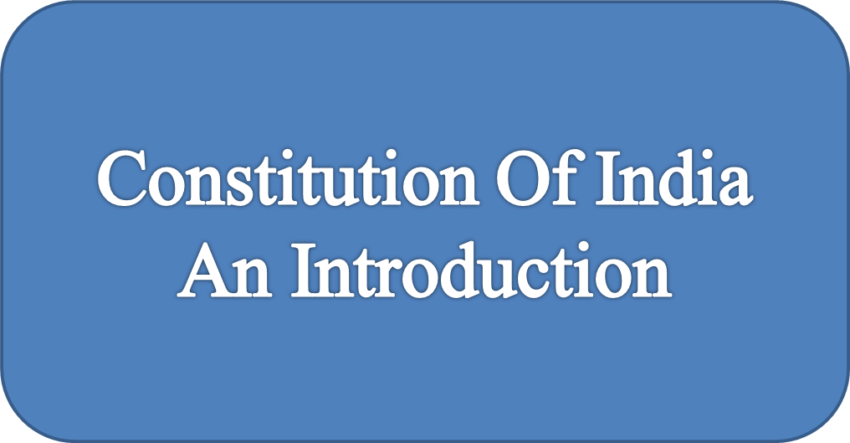Constitution of India An Introduction
Constitution of India
- The Constitution of India (Bharatiya Samvidhan) is the supreme law of India.
- It is the document of Constitution which lays down the structure of Govt. institutions, procedure of Govt. institutions, powers and duties of government institutions and It is the document of Constitution which sets out fundamental rights, directive principles and the duties of citizens.
- It is the longest written constitution on earth.
- B. R. Ambedkar was widely considered as Chief architect of the constitution. He was chairman of the drafting committee also. The document of Constitution was created by a constitutional assembly, So Constitution of India is the supreme law of India.
- It imparts constitutional supremacy (not parliamentary supremacy, since it was created by a constituent assembly rather than Parliament)It was adopted by its people with a declaration in its preamble. So, Parliament can’t override the constitution.
- It was adopted by the Constituent Assembly of India on 26 November 1949 and came in enforce on 26 January 1950.
- The constitution replaced the Government of India Act 1935 as the fundamental governing document of country and the Dominion (A dominion was a self governing autonomous state within the British Empire) of India became the Republic of India.
- Its framers repealed prior acts of the British parliament in Article 395 to ensure constitutional autochthony (is the process of asserting constitutional nationalism from an external legal or political power).
- India celebrates its constitution on 26 January as a Republic day.
Preamble of The Constitution of India
WE, THE PEOPLE OF INDIA, having solemnly resolved to constitute India into a SOVEREIGN SOCIALIST SECULAR DEMOCRATIC REPUBLIC and to secure to all its citizens:
JUSTICE, social, economic and political; LIBERTY of thought, expression, belief, faith and worship;
EQUALITY of status and of opportunity;
and to promote among them all FRATERNITY assuring the dignity of the individual and the unity and integrity of the Nation;
IN OUR CONSTITUENT ASSEMBLY this twenty-sixth day of November, 1949, do HEREBY ADOPT, ENACT AND GIVE TO OURSELVES THIS CONSTITUTION.
The constitution declares India a sovereign(a governing body’s full right and sovereignty over itself, without interference from foreign sources or bodies),
socialist (a political theory that supports political democracy within a socially owned economy),
secular (the state of being unattached or impartial to religion)
democratic republic (a form of government in which the people have the authority to choose their governing legislators), assuring its citizens
justice ( the principle that people receive what they deserve, according to constitutional interpretation)
equality (the notion that each autonomous being must be treated equally by the law)) and
liberty (opportunity to do whatever one wants) , and endeavours to promote
fraternity (brotherhood).
The original 1950 constitution is preserved in a helium (is a chemical element with the symbol )-filled case at the Parliament House in New Delhi. The words “secular” and “socialist” were added to the preamble in 1976 during the Emergency.
The constitution of India repealed the Indian Independence Act 1947 and Government of India Act 1935 when it came in force on 26 January 1950. With the constitution, India ceased to be a British Crown dominion and became a sovereign democratic republic. Articles 5, 6, 7, 8, 9, 60, 324, 366, 367, 379, 380, 388, 391, 392, 393, and 394 of the constitution came into force on 26 November 1949, and the remaining articles came in force on 26 January 1950.
“There are 105 amendments ( latest amendment took place on 10 August 2021) to restore the power of the state governments to identify Other Backward Classes (OBCs) that are socially and educationally backward. This amendment annulled the Supreme Court judgement of 11 May 2021, which had empowered only the Central government for such identification. “(Wikiepedia)
The world’s lengthiest written constitution had 395 articles in 22 parts and 8 schedules at the time of commencement. Now the Constitution of India has 395+53 amendment articles in 22+3 parts and 12 schedules.
Constitution of India – Flow Chart
| Part- I | The Union and Its Territory (Art. 1-4) | ||
| Part -II | Citizenship (Art. 5-11) | ||
| Part-III | Fundamental Rights (Art. 12- 35) | General (Art. 12-13) Right to Equality (Art. 14-18) Right to Freedom (Art. 19-22) Right against Exploitation (Art. 23-24) Right to Freedom of Religion (Art. 25-28) Cultural and Educational Rights (Art. 29-30) Saving of Certain Laws (Art. 31A -31D) Right to Constitutional remedies Art. (32-35) | |
| Part-IV | Directive Principles of State policy(Art. 36-51) | ||
| Part-IVA | Fundamental Duties (Art. 51A) | ||
| Part-V | The Union (Art. 52-151) | Ch.1 The Execution | The President and Vice President (Art. 52-73) Council of Ministers (Art. 74-75) The Attorney-General for India (Art.76) Conduct of Government Business (Art. 77-78) |
| Ch.-2 Parliament | General Art. (79-88) Officers of Parliament (Art. 89-98) Conduct of Business (Art. 99-100) Disqualification of Members( Art. 101-104) Powers, Privileges and immunities of Parliament and its Members ( Art. 105-106) Legislative Procedure(Art. 107-111) Procedure in Financial Matters ( Art. 112-117) Procedure Generally ( Art. 118-122) | ||
| Ch.-3 Legislative Powers of the President ( Art. 123) | |||
| Ch.-4 The Union Judiciary ( Art. 124-147) | |||
| Ch.-5 Comptroller andAuditor General of India ( Art. 148-151) | |||
| Part -VI | The States (Art. 152-237) | Ch.-1 General ( Art. 152) | |
| Ch.-2 The Executive | The Governor (Art. 153-162) Council of Ministers (Art.163-164) The Advocate General for the State (Art. 165) Conduct of Government Business (Art.166-167) | ||
| Ch.-3 The State Legislature | General (Art.168-177) Officers of the State Legislature ( Art. 178-187) Conduct of Business(Art. 188-189) Disqualifications of Members ( Art. 190-193) Powers, Privileges and immunities of State Legislatures and their Members ( Art. 194- 195) Legislative Procedure ( Art. 196-201) Procedure in Financial Matters ( Art. 202-207) Procedure Generally ( Art. 208-212) | ||
| Ch.-4 Legislative Power of the Governor ( Art. 213) | |||
| Ch.-5 The High Courts in the States (Art. 214-232) | |||
| Ch.-6 Sub-Ordinate Courts ( Art. 233-237) | |||
| Part -VII | The States in Part-B of the First Schedule( Art.238) Repeal | ||
| Part-VIII | The Union Territories ( Art. 239-242) | ||
| Part-IX | The Panchayats ( Art. 243-243o) | ||
| Part-IXA | The Municipaliies ( Art. 243P-243ZG) | ||
| Part-IXB | The Co- Operative Societies ( Art. 243ZH- 243ZI) | ||
| Part -X | The Schedule and Tribal Areas ( Art. 244-244A) | ||
| Part- XI | Relation between the Union and the States ( Art. 245-263) | Ch.-1Legislative Relations | Distribution of Legislative Powers ( 245 -255) |
| Ch.-2 Administrative Relations | General ( Art. 256-261) Disputes relating to Waters ( Art. 262) Co-ordination between States ( Art. 263) | ||
| Part- XII | Finance, Property, Contracts and Suits ( Art. 264-300A) | Ch.-1 Finance | General ( Art. 264- 267) Distribution of Revenues between the Union and the States ( Art. 268-281) Miscellaneous Financial Provisions ( Art. 282-291) |
| Ch.-2 Borrowing ( Art. 292-293) | |||
| Ch.-3 Property, Contracts,Rights, Liabilities, Obligations and Suits ( Art. 294-300) | |||
| Ch.-4 Right to Property ( Art. 300A ) | |||
| Part- XIII | Trade , Commerce and Intercourse within the Territory of India ( Art. 301-307) | ||
| Part- XIV | Services under the Union and the States ( Art. 308-323) | Ch.-1 Services ( Art. 308-314) | |
| Ch.-2 Public Service Commisions ( Art. 315-323) | |||
| Part- XIVA | Tribunals ( Art. 323A- 323B) | ||
| Part- XV | Elections ( Art. 324-329A) | ||
| Part- XVI | Special Provisions Relating to Certain Classes ( Art. 330-342A) | ||
| Part- XVII | Official Language ( Art. 343-351) | Ch.-1 Language of the Union( Art. 343-344) | |
| Ch.-2 Regional Languages ( Art. 345-347) | |||
| Ch.-3 Language og the Supreme Court, High Courts Etc. ( Art. 348-349) | |||
| Ch.-4 Special Directives ( Art. 350- 351) | |||
| Part-XVIII | Emergency Provisions(Art. 352-360) | ||
| Part- XIX | Miscellaneous ( Art. 361-367) | ||
| Part -XX | Amendment of the Constitution ( Art. 368) | ||
| Part -XXI | Temporary, Transitional and Special Provisions( Art. 369- 392) | ||
| Part-XXII | Short Title, Commencement, Authoritative text in Hindi and Repeal ( Art. 393- 395) | ||
Schedules of Constitution of India
| Schedules in Indian Constitution | |
| Schedules | Features of Schedules |
| First Schedule | It contains the name of States and Union Territories Territorial Jurisdiction of states is also included |
| Second Schedule | The provisions in relation to allowances, privileges, emoluments of: President of India Governors of Indian States Speaker of Lok Sabha & Deputy Speaker of Lok Sabha Chairman of Rajya Sabha & Deputy Chairman of Rajya Sabha Speaker and Deputy Speaker of Legislative Assemblies of Indian States Chairman and Deputy Chairman of Legislative Councils of the Indian States Supreme Court Judges High Court Judges Comptroller & Auditor General of India (CAG) |
| Third Schedule | It contains the forms of oath and affirmation for: Union Ministers of India Parliament Election Candidates Members of Parliament (MPs) Supreme Court Judges Comptroller and Auditor General State Ministers State Legislature Elections’ Candidates State Legislature Members High Court Judges |
| Fourth Schedule | It contains the provisions in relation to the allocation of seats for States and Union Territories in the Rajya Sabha |
| Fifth Schedule | It contains provisions in relation to the administration and control of scheduled areas and scheduled tribes |
| Sixth Schedule | It contains provisions in relation to the administration of tribal areas in the states of Assam, Meghalaya, Tripura and Mizoram |
| Seventh Schedule | This schedule deals with the three legislative lists: Union State Concurrent |
| Eighth Schedule | It deals with the 22 official languages recognized by the Indian Constitution: Assamese Bengali Bodo Dogri (Dongri) Gujarati Hindi Kannada Kashmiri Konkani Mathili (Maithili) Malayalam Manipuri Marathi Nepali Oriya Punjabi Sanskrit Santhali Sindhi Tamil Telugu Urdu |
| Ninth Schedule | It deals with the state acts and regulations of that deal with land reforms and abolition of the zamindari system. It also deals with the acts and regulations of the Parliament dealing with other matters. Note: 1st Amendment Act 1951 added the Ninth Schedule to protect the laws included in it from judicial scrutiny on the ground of violation of fundamental rights. However, in 2007, the Supreme Court ruled that the laws included in this schedule after April 24, 1973, are now open to judicial review |
| Tenth Schedule | It contains provisions relating to disqualification of the members of Parliament and State Legislatures on the ground of defection. Note: This schedule was added by the 52nd Amendment Act of 1985, also known as Anti-defection Law |
| Eleventh Schedule | It contains the provisions that specify the powers, authority and responsibilities of Panchayats. It has 29 matters. Note: This schedule was added by the 73rd Amendment Act of 1992 |
| Twelfth Schedule | It deals with the provisions that specify the powers, authority and responsibilities of Municipalities. It has 18 matters. Note: This schedule was added by the 74th Amendment Act of 1992 |

